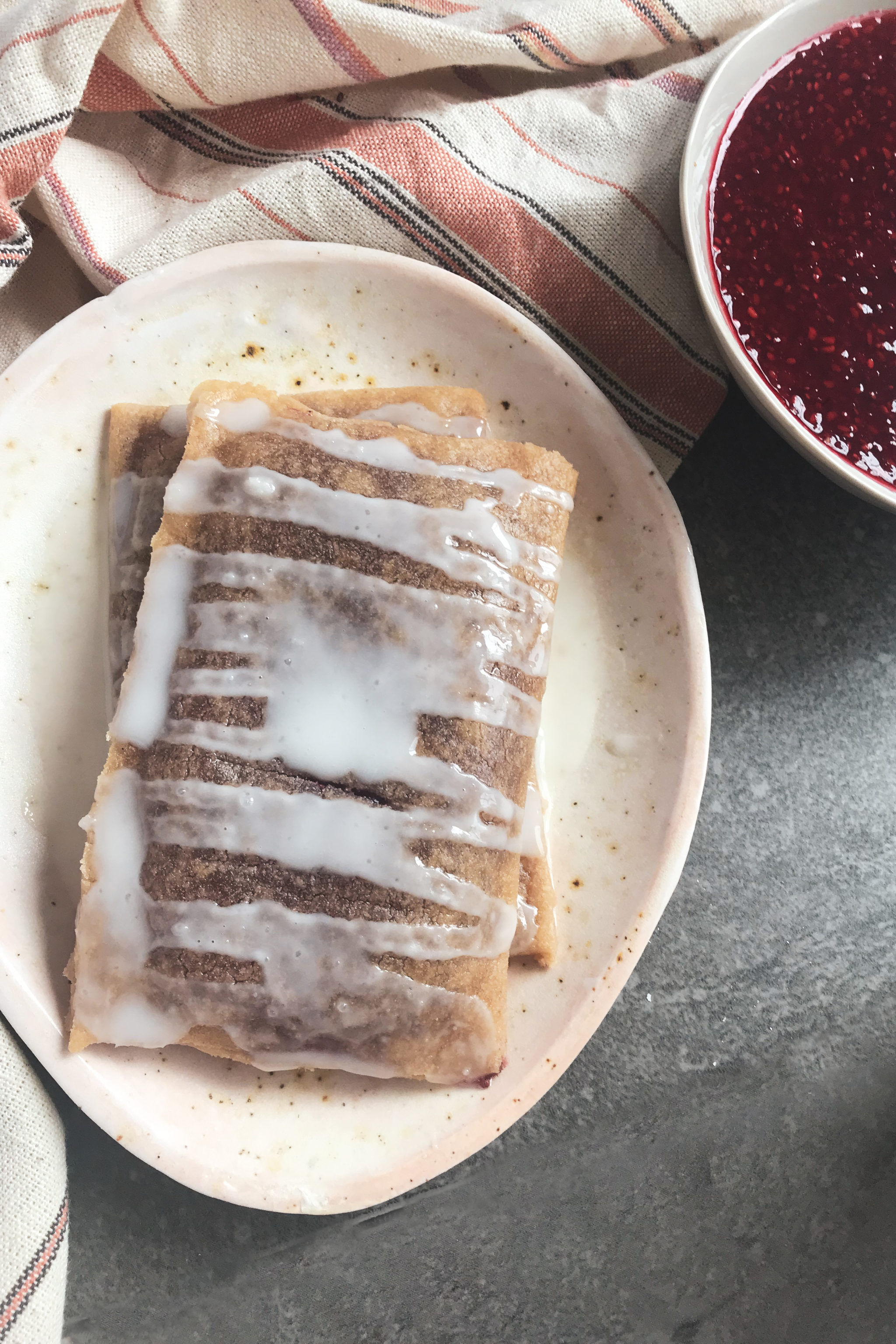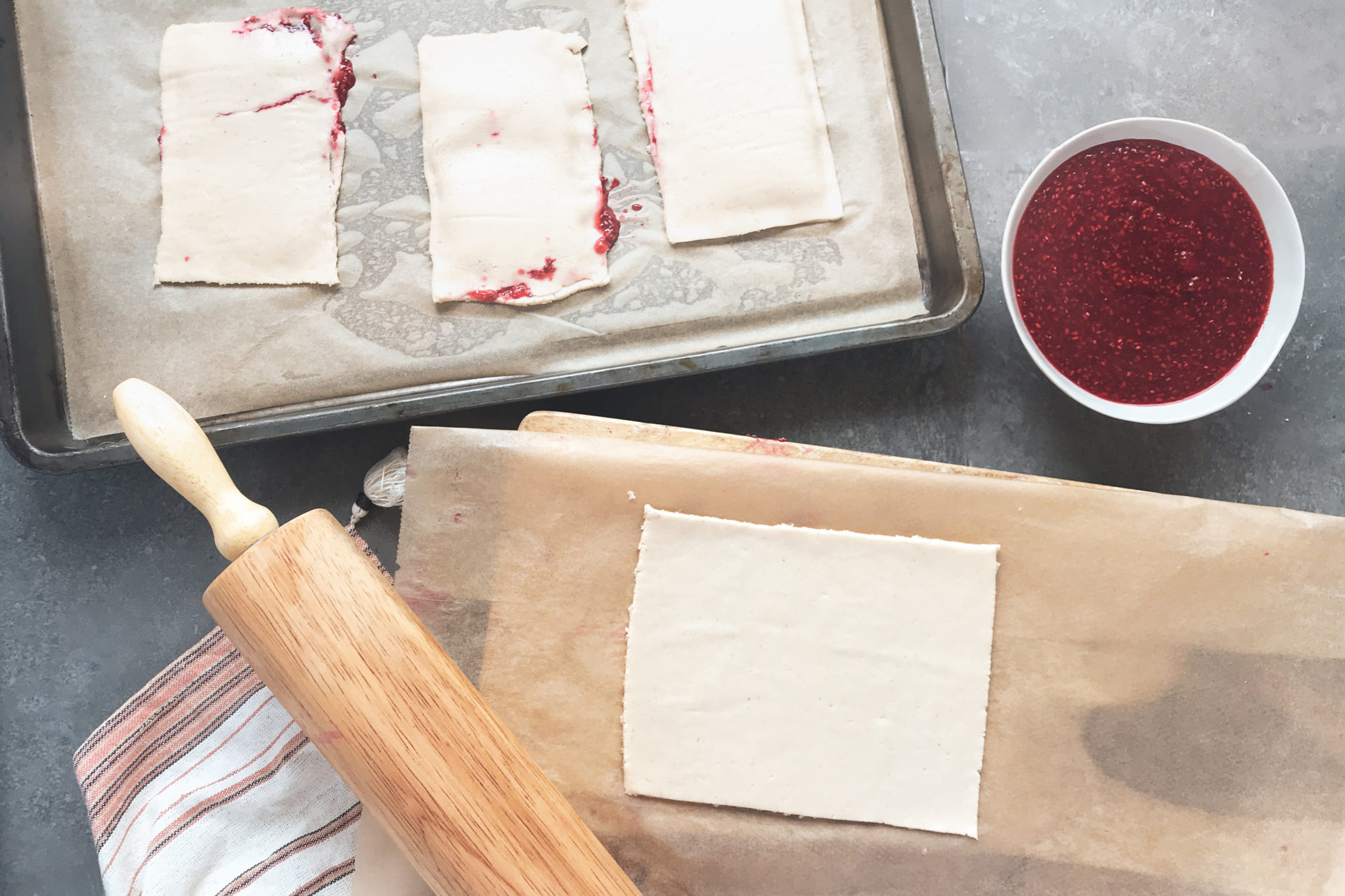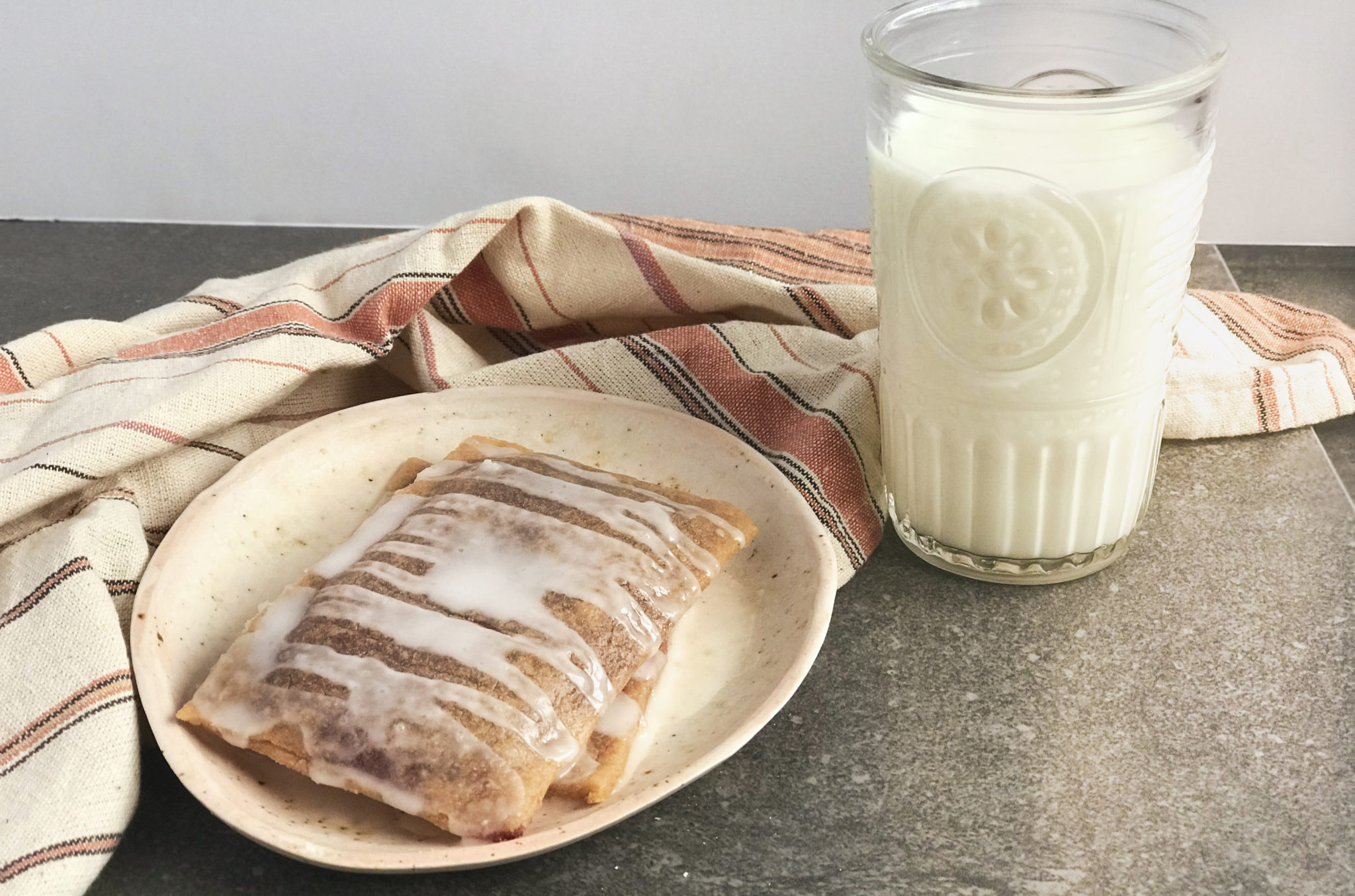This post contains affiliate links. Click here to see what that means! That being said, we only promote authors, products, and services that we use ourselves and wholeheartedly stand by. To learn more about how we earn money here on Autoimmune Wellness, head on over to our Promotional Policy.

I remember grocery shopping as a young girl, begging my mother to finally let us get those delicious, fruity little pockets of morning joy. Each time, thankfully, she would deny me. As a Nutritional Therapy Practitioner, the ingredient list on breakfast pastry is enough to make you blush.
Fast forward to my college days, I had my fair share of breakfast pastries (a.k.a. Pop-Tarts) and I’m here to tell you, I’ve got just the thing to cure your Pop-Tart craving. As always, working with AIP dough, be mindful of its delicacy. Utilize parchment paper when needed, use HOT water with this dough and add more water and oil as needed.

This recipe may leave you with more raspberry filling. Treat like a jam and store in your fridge, it will keep for about two weeks. It’s great on top of your favorite AIP crackers or even a sweet potato.

- Dough:
- 1 cup tapioca flour
- 1 cup cassava flour
- ¼ cup coconut sugar
- ¾ cup hot water
- ½ cup avocado oil
- Filling:
- 3-4 cups raspberries (I used frozen)
- 3 tablespoons maple syrup
- Juice of one lemon
- 2-3 scoops Vital Proteins beef gelatin
- Glaze:
- Coconut butter, melted
- In a medium-sized sauce pot on medium low, combine raspberries, lemon juice, and maple syrup. Reduce for about 15 minutes, stirring occasionally.
- Add gelatin and stir with a whisk until there are no more chunks.
- After the mixture has thickened quite a bit, remove from heat and allow cool before moving on.
- Preheat oven to 350 degrees F.
- In a large bowl, mix flours, coconut sugar, avocado oil and hot water. Knead dough until well-combined.
- With a rolling pin, flatten a portion of the dough out between two pieces of parchment paper. Make sure it is about 1-2 centimeters in thickness. You don’t want it too thin or too thick.
- Cute into a large rectangle, about 6x4 inches. Spoon 1-2 teaspoons of the raspberry mixture onto one half of the dough. Be careful not to reach the edges of the dough so that it will seal properly. You can see how I screwed up a couple. No worries! They still taste good.
- Using the parchment paper to guide one side of the dough to meet the other side, enclosing the raspberry filling. The dimensions should now be about 3X2.
- Pinch the edges just a bit to ensure that now filling spews out.
- Transfer carefully to a parchment-lined baking sheet. I used the parchment paper that it was on to carefully roll it onto the baking sheet.
- Bake for about 15-20 minutes.
- Top with coconut butter glaze and serve!
















25 comments
Do you happen to know if these freeze well?
[…] Raspberry Filled Breakfast Pastry from Autoimmune Wellness *Here's an AIP revamp of the well-known breakfast pastries. […]
Could you please try to incorporate using white sweet potatoes shredded and uncooked in your bread, pastry recipes. Tapioca and Cassava flour is too much for some of us more sensitive people. Maybe you could use a small amount of really pure finely ground almond meal, a small amount of coconut flour,(more than 2 T of coconut except for oil is too much for more sensitive tummies), using the small amount of coconut flour as you would Xanthum gum to soak up excess moisture, and possibly using small amount of arrowroot, coconut flour, and cassava but in a combination not using anymore than 2 T of each including the almond flour.
Thank you so much for your great work!
Hi Rhonda! We have various dessert recipes in our archives that are coconut and/or cassava free, but we do not write all our recipes as such as many folks tolerate these ingredients just fine. Almond flour is not an AIP compliant ingredient, so you won’t find it in our elimination friendly recipes. Hope it helps!
I would be able to make this recipe without the Vital proteins beef gelatin? Or is there something I would be able to substitute for it?
Could I substitute the tapioca with arrowroot?
It would be lovely for our Christmas Breakfast. Thank you!
I would also like to know if you are able to substitute tapioca with arrow root. Thanks
Could someone provide a measurement amount for the gelatin? I have a different brand and don’t know how much a ‘scoop’ yields.
Charisse Squires
I checked out the gelatin ingredient info and it said 2 scoops is 20grams
Hello! I’d love to try this but am confused about the amount of carbs and sugar (even natural sugar). I thought you could only have a tsp of (acceptable) added sugar a day on AIP? Does the raspberry filling and icing and cassava all turn to sugar?
Nichole-
I’m not sure where you saw the recommendation to only consume 1 tsp of acceptable added sugar/day on AIP, but that’s not necessarily the guideline. Basically, AIP is a very low-sugar, but not a no-sugar protocol. When it comes to fructose, the recommendation per Dr. Sarah Ballantyne is 10-20 grams/day, which works out to about 2-4 pieces of fruit, depending on the types. There will be sugar in all three ingredients you mentioned, but that doesn’t mean you can’t try these. Instead, really know yourself & your limits w/ sugar. If this recipe seems like it will lead to overeating sugary treats, maybe avoid it or only make enough to share w/ the family & then they are gone. Hope this was helpful!
Hello,
What if you have candida & SIBO as well as autoimmune disorder (psoriasis) is it therefore best to eliminate natural sugar sweeteners even such as pure monk fruit? (I’ve not had sugar nor any kind of natural sugar sweeteners for 5 months now whilst trying to heal my gut).
Thanks 🙂
Faiza, whether or not to entirely eliminate all sugars in order to treat a particular condition, like candida or SIBO, is something you should discuss w/ your healthcare provider.
They look delicious. Can we freeze them?
Does cassava flour and coconut flower act the same? I am not a fan of the cassava so would like to use coco flower if possible in all your receipes, just need to know if any different ratios.
thanks!
Hi Sabrina! No, cassava and coconut have VERY different textures and do not swap easily. My recommendation would be to pick recipes that avoid the ingredient you don’t tolerate. We have many desserts on the site that don’t use cassava.
I’ve been wanting to eat poptarts again for YEARS now, since I was a child, and I am BEYOND excited that this recipe exists! Thank you!
We are excited for you too, Meghan! Let us know how it goes!
Great recipe! I love that the edges get crispy and the middle stays soft. For those wondering about the gelatin measurement, I made half the recipe and used 15 grams of gelatin. It made it quite thick when it cooled but after it was baked the consistency was perfect.
Just a couple changes/typos the editors might want to change. I think perhaps the thickness is meant to be in millimeters? 1-2 centimeters is almost 1/2-3/4 in inches. In step 7 Cute should be Cut 🙂
I have lots of raspberry juice that never became jelly. Any suggestions for thickening it for use as filling?
Thank you!
My dough was very chewy. What did I do wrong?
First, to those of you asking if you can sub arrowroot for tapioca, yes you can!
Second, I’m giving the recipe 3 stars because this is quite a frustrating dough. The end result tasted fine, but the process of making it was trying as it didn’t hold together well. I would recommend chilling the dough before trying to work with it. I think this step will help in preventing tearing.
Barbara, arrowroot and tapioca don’t have the same texture, so if you make a substitution there it might not turn out. I imagine that might be why you didn’t like the dough you worked up.
This recipe looks so delicious. When I attempted, my dough just kept crumbling and resembled more of a shortbread cookie dough than pastry. I did sub coconut oil for avocado oil, but other than that, followed the recipe to a T. Do you have any ideas about what happened? I literally couldn’t remove it from the parchment paper, it would just crumble in my hands.
Hello! I’m going to try to make these, but want to see two things: 1) How long is their shelf life if kept in the fridge, and 2) Do they freeze well if they don’t keep in the fridge? I am the only one in my family AIP, so I don’t think these will be eaten by others. Let me know!